Johan Tobias Sergel
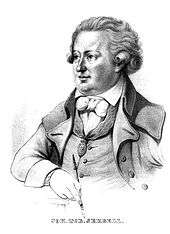
Johan Tobias Sergel (Swedish pronunciation: ['sar·gɛl])[1] (Stockholm 7 September 1740 – 26 February 1814 Stockholm) was a Swedish neoclassical sculptor.
Life
Johan Tobias Sergel was born in Stockholm in 1740. He was the son of the decorator, Christoffer Sergel and Elisabet (née Swyrner), and was the brother of the decorator, Anna Brita Sergel. His first teacher was Pierre Hubert Larchevêsque.[2] After studying in Paris, he went to Rome.[3] He stayed in Rome for twelve years and sculpted a number of groups in marble. Besides subjects from classical mythology such as the Diomedes Stealing the Palladium, which he sold to the British collector, Thomas Mansel Talbot, in 1772, he also sculpted a colossal representation of The Muse of History Recording the Deeds of Gustavus Adolphus, in which are depicted the achievements of King Gustav II Adolf before the Chancellor, Axel Oxenstierna. It was in Rome also that he modelled the statue of King Gustav III, subsequently cast in bronze and purchased by the city of Stockholm in 1796. While primarily a sculptor, Sergel (inspired by English artists like Thomas Rowlandson) also drew sequential picture stories, an early form of comic strip.[3]
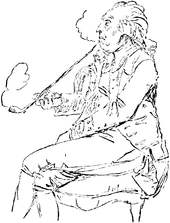
Summoned by Gustav III, Sergel returned to Stockholm in 1779 and continued to work there. Among the monuments he created at this time are a tomb for Gustav Vasa, a monument to Descartes, and a large relief in the church of St. Clarens, representing the Resurrection. He was an important part of the artistic elite in Stockholm, drawing a portrait of Sweden's bard Carl Michael Bellman among others. He had a relationship with the celebrated actress Fredrique Löwen and was possibly the father of one of her children. He died in his native city on 26 February 1814.[3]
Legacy
Sergels torg, the largest square in the centre of Stockholm, is named after him. His workshop was nearby.[4]
Works
Among his works in the Nationalmuseum in Blasieholmen, central Stockholm are his monumental sculptures "Diomedes Stealing the Palladium", "The Muse of History Recording the Deeds of Gustavus Adolphus", and a "Bust of Gustavus III".[2]
 Centaur embracing a bacchante, terracotta, 1775-1778
Centaur embracing a bacchante, terracotta, 1775-1778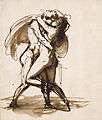 Passionate couple, wash drawing, n.d.
Passionate couple, wash drawing, n.d. Venus and Anchises, n.d.
Venus and Anchises, n.d. Woman climbing out of bath, plaster relief, n.d.
Woman climbing out of bath, plaster relief, n.d.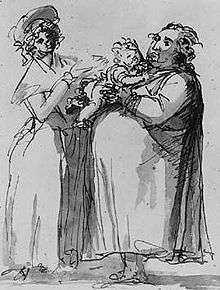 Self-portrait with his common-law wife Anna-Rella Hellström and their son Gustav, wash drawing, 1793
Self-portrait with his common-law wife Anna-Rella Hellström and their son Gustav, wash drawing, 1793 Sculpture of Axel Oxenstierna, on the south side of the postament of the Gustav II Adolf monument in Stockholm, bronze, 1796
Sculpture of Axel Oxenstierna, on the south side of the postament of the Gustav II Adolf monument in Stockholm, bronze, 1796 Dancing bacchante, crayon on paper, n.d.
Dancing bacchante, crayon on paper, n.d. Caricature of Frantz Christopher Henrik Hohlenberg (1764-1804), Danish shipbuilder and naval officer, 1797
Caricature of Frantz Christopher Henrik Hohlenberg (1764-1804), Danish shipbuilder and naval officer, 1797 Altar cross of Karlstad Cathedral
Altar cross of Karlstad Cathedral Statue of King Gustav III of Sweden, Skeppsbron, Stockholm. Dedicated 1808
Statue of King Gustav III of Sweden, Skeppsbron, Stockholm. Dedicated 1808 Tomb of Field Marshal Augustin Ehrensvärd's grave at Suomenlinna, 1805
Tomb of Field Marshal Augustin Ehrensvärd's grave at Suomenlinna, 1805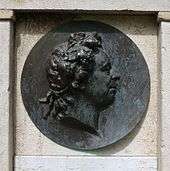 Medallion of Carl Michael Bellman, Bellmanskällan. Bronze
Medallion of Carl Michael Bellman, Bellmanskällan. Bronze
References
Sources
 Gilman, D. C.; Thurston, H. T.; Colby, F. M., eds. (1905). "Sergel, Johan Tobias". New International Encyclopedia (1st ed.). New York: Dodd, Mead.
Gilman, D. C.; Thurston, H. T.; Colby, F. M., eds. (1905). "Sergel, Johan Tobias". New International Encyclopedia (1st ed.). New York: Dodd, Mead.
- Attribution
-
 This article incorporates text from a publication now in the public domain: Chisholm, Hugh, ed. (1911). "Sergel, Johan Tobias". Encyclopædia Britannica (11th ed.). Cambridge University Press.
This article incorporates text from a publication now in the public domain: Chisholm, Hugh, ed. (1911). "Sergel, Johan Tobias". Encyclopædia Britannica (11th ed.). Cambridge University Press.
External links
| Wikimedia Commons has media related to Johan Tobias Sergel. |
- Johan Tobias Sergel at Lambiek artists archive.